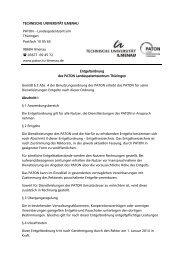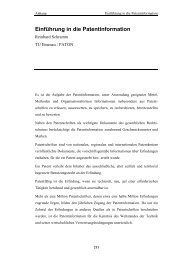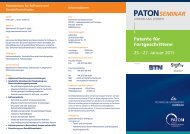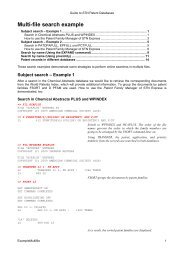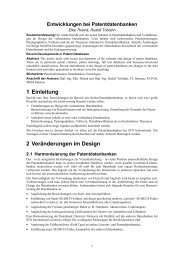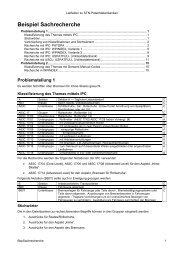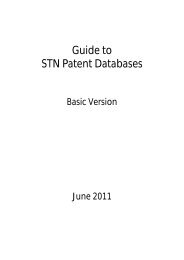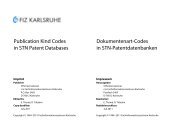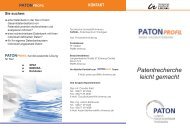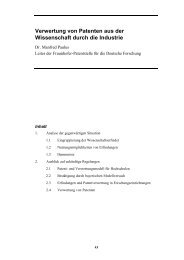Guide to STN Patent Databases – Basic Version - Paton - TU Ilmenau
Guide to STN Patent Databases – Basic Version - Paton - TU Ilmenau
Guide to STN Patent Databases – Basic Version - Paton - TU Ilmenau
You also want an ePaper? Increase the reach of your titles
YUMPU automatically turns print PDFs into web optimized ePapers that Google loves.
Types of search<br />
However, a detailed analysis by the EPO of given patent documents can lead <strong>to</strong> some priorities being considered<br />
"non-active". This means that these priorities are ignored for simple patent families. This assessment may change<br />
when new facts come up, e.g. a new publication. It may be said that define the<br />
technical contents of the simple family . WO priorities are often non-active because they share the same technical<br />
contents with the national applications. Active and non-active priorities are marked in the documents (Y = active<br />
priority, N = non-active priority).<br />
PATENT FAMILY INFORMATION<br />
AN 35175373 INPAFAMDB<br />
=================================<br />
EPO simple family (SFN): 37031203<br />
=================================<br />
Y: active priority<br />
N= non-active priority.<br />
WO 2007009624.<br />
+-------- Publications --------+ +-------- Applications --------+<br />
DE 102005034274 A1 20070125 DE 2005-102005034274 A 20050722<br />
JP 2009503313 T 20090129 JP 2008-521843 T 20060708<br />
US 20080216788 A1 20080911 US 2008-9848 A 20080122<br />
WO 2007009624 A1 20070125 WO 2006-EP6710 W 20060708<br />
+--------- Priorities ---------+ +------------------+<br />
DE 2005-102005034274 A 20050722 (DEA, 20070208, Y)<br />
WO 2006-EP6710 W 20060708 (WOWW, 20081016, N)<br />
2 priorities, 4 applications, 4 publications<br />
22.4.2 DWPI<br />
All family members in one database document have the same priorities as the <strong>Basic</strong> <strong>Patent</strong>, the first family member<br />
that was used for indexing by Thomson Reuters.<br />
When a new priority appears this publication is the basis for a new document in the database:<br />
Each database document has a reference <strong>to</strong> other documents belonging <strong>to</strong> the same family in the CR<br />
(Cross Reference) field<br />
Complex patent families result from multiple priorities being assigned <strong>to</strong> one patent application, in<br />
particular if there are Continuations in part.<br />
The DWPI family is well suited <strong>to</strong> find closely related family members in a big patent family which is beneficial when<br />
reviewing search results.<br />
Different <strong>Basic</strong> <strong>Patent</strong>s may be used for indexing in DWPI and CAPLUS.<br />
22.4.3 CAPLUS<br />
All family members in one database document have the same priorities as the <strong>Basic</strong> <strong>Patent</strong>. In case of complex<br />
patent families more than one document is created in the database for one family.<br />
In contrast <strong>to</strong> DWPI the same patent numbers may appear in more than one database document.<br />
Whether a new family document is created is decided based on the priorities. New family documents are created in<br />
CAPLUS when new priorities appear. A hint that there are other documents of the same family can be found in the<br />
FAN.CNT (Family Accession Number Count) field.<br />
Other reasons <strong>to</strong> create more than one document in the database for a family are:<br />
Many substances that must be indexed, exceeding the limit for one document.<br />
From 2008-07-01 one family document is created and indexed for the oldest national priority of US, DE, GB,<br />
FR, CA, EP and a second document for the WO application (WO documents often contain more information,<br />
including more chemical structures).<br />
149



